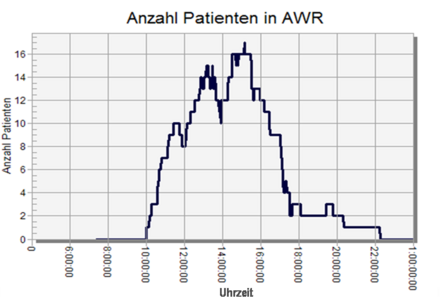OR simulation
The OR simulation is a computer-aided tool to realistically map OR processes in existing and / or planned buildings, from the premedication to the return transport of the patient, virtually with real data.
The OR simulation has its origins in industry, especially in the automotive sector. With simulations , factories including material flow and production are planned in detail and virtually anticipated ( digital factory ). In this way, errors in planning are uncovered before implementation and target achievement is checked in €. With the simulation, the causes of errors in processes can also be identified more quickly during operation. Solutions or measures can be tested directly for success before implementation begins. In industry as well as in a clinic, all available data circuits, resources and relevant processes are recorded, combined with the building layout and digitally mapped. In the clinic, this ranges from the surgeon and his scalpel, the cleaning staff, personnel and vacation planning to the dimensioning and arrangement of rooms. The simulation is then used to digitally map the entire surgical procedure for a year in existing or planned rooms as a "virtual process".
aims
- Reduction of changeover times,
- Increase in the number of cases and productivity ,
- Reduction of personnel costs
- exact dimensioning of staff, shifts and rooms,
- Clarification whether central or decentralized introduction,
- Protection of new construction and renovation plans,
- Early error detection before commissioning,
- Harmonization of commissioning
- Identification of bottlenecks,
- Optimization of layout in accordance with the processes.
The use of simulation makes it possible to change various parameters of the model with just a few clicks after importing real-time data from the past . The simulation thus provides flexible, x-fold complex calculations until the variables interact in such a way that the best possible overall result (optimized target process in optimized target layout) is achieved. The use of simulation technology represents a high entrepreneurial added value for the clinics: processes can be optimized, existing resources can be used efficiently and new or reconstruction measures can be designed and dimensioned accordingly function-oriented. Above all, as efficient change times as possible between the individual operations guarantee the best possible utilization of all resources. With the OR simulation, changing times can be reduced by more than 50%. The securing of the first cut, the continuous utilization of the team and operating theaters until the end of the shift and the same-day fulfillment of the elective program despite emergencies, exact dimensioning of operating theaters, AWR places, holding area, ITS beds, etc. have been achieved and implemented goals. For the clinics, this means slightly more revenue of a few million euros per year. As soon as the measures derived from the simulation take effect, not only the clinic staff but also the patients benefit: The working atmosphere improves significantly - for example by eliminating overtime or a more structured assignment of tasks. In addition, measurable improvements in patient care are achieved through more transparency, optimal building arrangements, dimensions and optimized processes. UNITY's surgical simulation was awarded the Health Industry Future Prize in 2009 by the Club of the Health Industry (cdgw) and the Austrian Constantinus International Special Prize for Consulting and IT in 2010.
swell
- Fischlein, J .; Pfänder, T .: Industrial Clinic Management - Effective Management Principles Transferred to Current Challenges in Clinics , Finanzbuch-Verlag, Munich August 2008, bound ISBN 978-3-89879-330-8
- Project example OP simulation
- Simulation in the OR , in KU Health Management 01/2009 p. 12.
- Optimizing processes on the screen , meditec international 05/2009 p. 10.
- Process optimization in clinics , in Berlin Medical 01/2009 p. 38.
- IT is not an end in itself - Successful development of an IT strategy for clinics with scenario technology , Berlin Medical 02/2009, p. 24.
- Optimizing clinical processes with simulation technology , in the Health Management Yearbook 2009 p. 173.
- Study: ICT as a driver of structural change , third international IT summit (01/2009)
- Keep an eye on the supply chain , Krankenhaus Technik + Management 12/2008 p. 24.
- Balancing act between costs and quality , in Krankenhaus Technik + Management 09/2008 p. 25.
- Putting the PS on the road , in ku special issue (12/2007)
- IT remains a booming industry , in kma report (03/2009)


